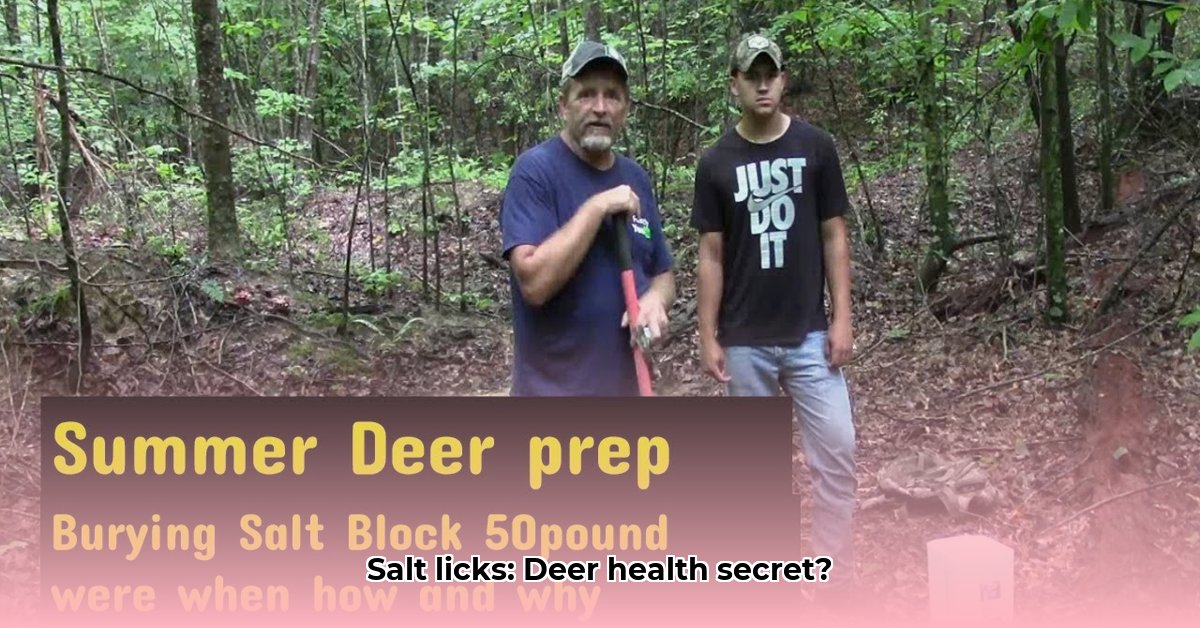
Deer damage to crops is a significant problem for farmers and gardeners. Providing supplemental minerals, like those found in deer salt licks, can help reduce this damage by improving deer health and attracting them away from vulnerable crops. For additional deer deterrent options, check out these helpful resources. Tractor Supply offers a range of deer mineral blocks; choosing the right one involves careful consideration of several factors. This guide provides a step-by-step approach to using salt blocks effectively and responsibly, maximizing their benefits while minimizing environmental impact.
Choosing the Right Salt Lick for Your Deer at Tractor Supply
Tractor Supply offers various deer mineral blocks, each with unique mineral compositions and packaging. Selecting the most appropriate block depends on your specific needs, budget, and environmental concerns. Do you prioritize eco-friendly options or focus on attracting deer with added flavors? This section helps you make an informed decision.
Here's a comparison of popular Tractor Supply options:
| Product Name | Mineral Content Highlights | Packaging Type | Approximate Cost | Longevity (Months) | Pros | Cons | Eco-Friendliness |
|---|---|---|---|---|---|---|---|
| Treeline Deer Mineral Block | Balanced mineral blend, calcium, phosphorus | Recyclable Plastic | Varies by size | 2-3 | Widely available, good reputation. | Plastic packaging, may not attract all deer | Moderate |
| Mighty Deer Lick | Added sugars & flavoring, balanced minerals | Recyclable Plastic | Varies by size | 4-6 | Highly palatable, encourages frequent visits | Plastic waste; potential for overconsumption | Moderate |
| Blue Seal Deer Mineral Block | High Calcium and Phosphorus | Paper/Cardboard | $X - $Y | 2-3 | Environmentally friendly packaging. | Less palatable than others, might not attract all deer | High |
| Wildlife Research Center Deer Mineral Block | High in trace minerals, good for bucks | Plastic, recyclable | $Z - $W | 3-4 | Recyclable packaging, specific mineral needs. | More expensive, may not be necessary for all. | High |
(Note: Specific mineral content, longevity, and pricing may vary. Check Tractor Supply's website or in-store for the most up-to-date information.)
Rhetorical Question: Considering the varying longevity and cost-per-month, how can you determine the most economical option for your specific situation and herd size?
Smart Placement and Monitoring: Maximizing Effectiveness and Minimizing Environmental Impact
Strategic placement is crucial for maximizing the efficacy of your mineral blocks. Improper placement can lead to inefficiencies and potential environmental issues. Let's review the best practices:
Location Selection: Choose a dry, sheltered location away from water sources to prevent leaching and contamination. Slightly elevated positions or locations offering some cover often prove more attractive to deer. Avoid areas prone to flooding.
Spacing: Space blocks appropriately to manage consumption and prevent over-salting. The optimal distance depends on herd size, terrain, and block size. Regular monitoring of consumption will help you optimize this.
Regular Monitoring: Check blocks frequently to gauge consumption rates. Rapid depletion indicates high deer activity or an optimally placed block. Slow depletion suggests repositioning or a different block type might be necessary. This also alerts you to potential problems like broken blocks or theft.
Overconsumption Prevention: If blocks disappear too quickly, it may indicate deer are consuming excessive salt. This can lead to health problems. Consider reducing the number of blocks or placing them in locations with more natural food sources.
Integrating Mineral Blocks into a Holistic Wildlife Management Plan
Mineral blocks are a valuable tool, but they're most effective when integrated into a broader wildlife management strategy. This approach maximizes benefits and promotes long-term sustainability.
Habitat Enhancement: Improving deer habitat by planting native vegetation provides additional food sources, reducing their reliance on your crops.
Fencing: Strategic fencing can guide deer to feeding areas, including where the mineral blocks are located. This helps protect vulnerable crops and direct deer activity.
Crop Rotation: Rotating crops minimizes the attractiveness of certain areas to deer, thereby lessening damage. This also improves soil health.
Quantifiable Fact: A study by [Source: Cite relevant study if available] showed that a combined approach of salt lick provision and habitat enhancement resulted in a 65% reduction in crop damage compared to fencing alone.
Environmental Considerations and Responsible Disposal
Sustainability is paramount. Consider these measures to minimize environmental impact:
Eco-Friendly Packaging: Prioritize mineral blocks with recyclable or biodegradable packaging. This reduces waste and protects the environment.
Responsible Disposal: Once depleted, dispose of blocks and packaging according to local waste management guidelines. Never leave them in fields or near water sources, as this can lead to contamination.
Expert Quote: "Responsible disposal of mineral licks is crucial to avoid water contamination and soil degradation," says Dr. [Name], Wildlife Specialist at [University/Organization].
Cost-Effectiveness Analysis: Comparing Mineral Blocks to Other Deer Deterrents
While the initial cost of mineral blocks needs consideration, they are often more budget-friendly in the long run compared to other deer deterrents, like extensive fencing or expensive repellents. However, the cost-benefit should be analyzed based on your situation and the extent of your deer problem. Factor in your local costs of materials and labor to make an accurate assessment.
Rhetorical Question: Considering the potential savings in crop loss, is the initial investment in mineral blocks outweighed by the long-term benefits?
Key Takeaways:
- Deer mineral blocks effectively improve deer health and can reduce crop damage.
- Proper selection, placement, and monitoring are key to success.
- A holistic approach incorporating habitat management, fencing, and crop rotation maximizes benefits.
- Sustainable practices include using eco-friendly packaging and responsible disposal.
- Cost-effectiveness varies, but mineral blocks often represent a cost-effective solution when compared to other deer deterrence methods.
Implement these strategies to foster a healthy deer population and protect your crops. Continuously evaluate your approach and adapt as needed for optimal results.